6. Advanced functionality#
import numpy as np
import torch
import matplotlib.pyplot as plt
from reflectorch import *
from reflectorch.inference.plotting import print_prediction_results, plot_reflectivity
torch.manual_seed(0); # set seed for reproducibility
6.1. Using alternative parameterizations of the SLD profile#
In this section we describe alternative parameterizations of the SLD profile implementated in reflectorch (i.e. other than the standard box model parameterization)
6.1.1. Model with absorption#
The default box model parameterization of the SLD profile presented in the previous sections takes into account only the real part of the SLD profile but neglects the imaginary part of the SLD which is related to the absorption of the scattering medium. While this is a reasonable approximation in many use cases, in reflectorch we are able to alter the parameterization of the SLD profile as to also incorporate the constant imaginary SLD value of each layer.
We can initialize a reflectorch model with absorption by making the following changes to the YAML configuration file:
Firstly, we set the
model_nameargument of the prior sampler tomodel_with_absorptioninstead ofstandard_model. In addition, the parameter range and bound width range of the imaginary layer SLDs (islds) must be specified. Ifconstrained_isldis set totrue, the imaginary part of the SLD is constrained to not exceed a predefined fractionmax_sld_shareof the real part of the SLD (Note:constrained_roughnessmust also betrue).
dset:
cls: ReflectivityDataLoader
prior_sampler:
cls: SubpriorParametricSampler
kwargs:
param_ranges:
thicknesses: [1., 500.]
roughnesses: [0., 60.]
slds: [0., 150.]
islds: [0., 30.]
bound_width_ranges:
thicknesses: [1.0e-2, 500.]
roughnesses: [1.0e-2, 60.]
slds: [ 1.0e-2, 5.]
islds: [1.0e-2, 5.]
model_name: model_with_absorption
max_num_layers: 2
constrained_roughness: true
constrained_isld: true
max_thickness_share: 0.5
max_sld_share: 0.2
logdist: false
scale_params_by_ranges: false
scaled_range: [-1., 1.]
device: 'cuda'
For the 2-layer box model parameterization of the SLD profile without absorption, the neural network had to predict 8 values (2 thicknesses, 3 roughnesses, 3 real layer SLDs). When absorption is considered, we have 3 additional output values (the imaginary layer SLDs), summing up to a total of 11. The computation for a higher number of layers is analogous. Thus the neural network architecture must also reflect these changes in the input and output dimensionalities: in this example the
dim_outargument is set to 11.
model:
network:
cls: NetworkWithPriors
pretrained_name: null
device: 'cuda'
kwargs:
embedding_net_type: 'conv'
embedding_net_kwargs:
in_channels: 1
hidden_channels: [32, 64, 128, 256, 512]
kernel_size: 3
dim_embedding: 128
dim_avpool: 1
use_batch_norm: true
activation: 'gelu'
pretrained_embedding_net: null
dim_out: 11
dim_conditioning_params: 0
layer_width: 512
num_blocks: 6
repeats_per_block: 2
residual: true
use_batch_norm: true
use_layer_norm: false
mlp_activation: 'gelu'
conditioning: 'concat'
We initialize a model with absorption from a suitable configuration file.
trainer = get_trainer_by_name(config_name='a_base_point_xray_conv_absorption', load_weights=False)
Model a_base_point_xray_conv_absorption loaded. Number of parameters: 3.84 M
We observe that the parametric model is ModelWithAbsorption and the sampler strategy is ConstrainedRoughnessAndImgSldSamplerStrategy
trainer.loader.prior_sampler.model_name, trainer.loader.prior_sampler.param_model, trainer.loader.prior_sampler.param_model.sampler_strategy
('model_with_absorption',
<reflectorch.data_generation.priors.parametric_models.ModelWithAbsorption at 0x27077b0b1c0>,
<reflectorch.data_generation.priors.sampler_strategies.ConstrainedRoughnessAndImgSldSamplerStrategy at 0x27077b0b280>)
batch_size = 64
simulated_data = trainer.loader.get_batch(batch_size)
n_layers = simulated_data['params'].max_layer_num
n_params = simulated_data['params'].num_params
print(f'Number of layers: {n_layers}, Number of film parameters: {n_params}')
print('SLD data type: ' + str(simulated_data['params'].slds.dtype))
print('Img slds properly constrained with respect to real slds: ' + str(torch._is_all_true(simulated_data['params'].slds.imag < 0.2*simulated_data['params'].slds.real).item()))
Number of layers: 2, Number of film parameters: 11
SLD data type: torch.complex128
Img slds properly constrained with respect to real slds: True
We observe that the slds tensor is of complex type now. The absorption leads to the rounding of the total reflection edge and the smoothing-off of oscillations of the reflectivity curve.
Show code cell source
q = to_np(simulated_data['q_values'])[0]
scaled_noisy_curves = simulated_data['scaled_noisy_curves']
fig, ax = plt.subplots(1,2,figsize=(12,6))
ax[0].set_ylim(-1.1, 1.1)
ax[0].set_xlabel('q [$Å^{-1}$]', fontsize=18)
ax[0].set_ylabel('R$_{scaled}$ (q)', fontsize=18)
ax[0].tick_params(axis='both', which='major', labelsize=14)
i = 0
ax[0].scatter(q, to_np(scaled_noisy_curves[i]), c='blue', s=2.0);
z_axis = torch.linspace(-200, 1000, 1000, device='cuda')
_, sld_profile_real, _ = get_density_profiles(
simulated_data['params'].thicknesses,
simulated_data['params'].roughnesses,
simulated_data['params'].slds.real,
z_axis=z_axis)
_, sld_profile_imag, _ = get_density_profiles(
simulated_data['params'].thicknesses,
simulated_data['params'].roughnesses,
simulated_data['params'].slds.imag,
z_axis=z_axis)
ax[1].plot(to_np(z_axis), to_np(sld_profile_real[i]), c='cyan', label='Re(SLD)')
ax[1].plot(to_np(z_axis), to_np(sld_profile_imag[i]), c='violet', label='Im(SLD)')
ax[1].set_xlabel('z [$Å$]', fontsize=20)
ax[1].set_ylabel('SLD [$10^{-6} Å^{-2}$]', fontsize=20)
ax[1].tick_params(axis='both', which='major', labelsize=15)
ax[1].tick_params(axis='both', which='minor', labelsize=15)
ax[1].legend(fontsize=14)
plt.tight_layout()
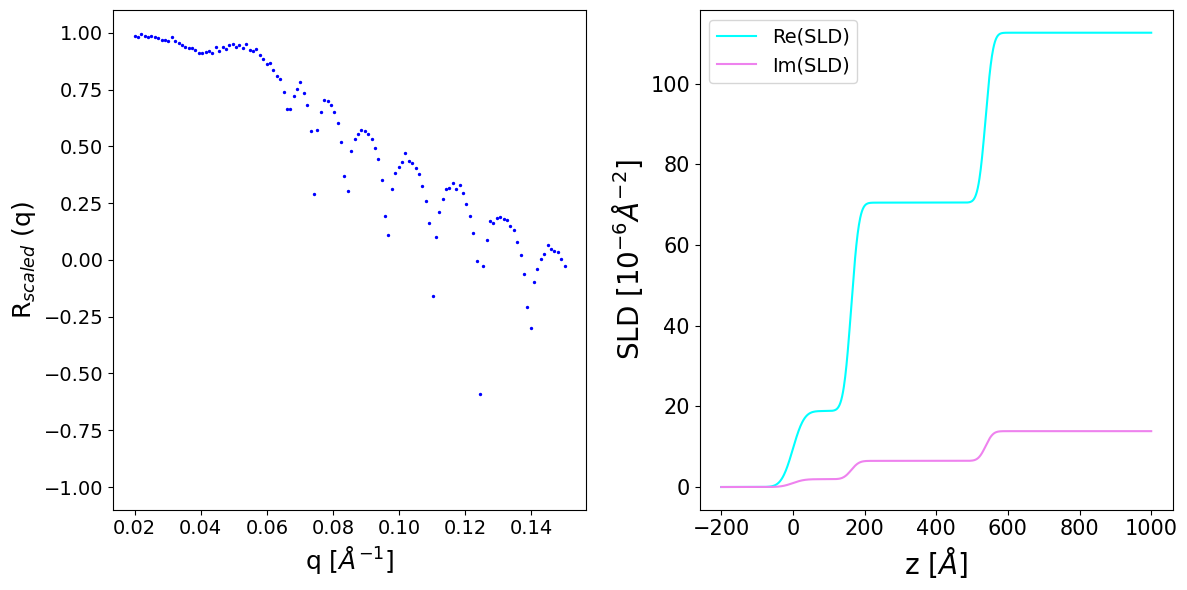
6.1.2. Periodically repeating monolayer#
This SLD parameterization addresses the following commonly encountered scenario for thin films. On top of a silicon/silicon oxide substrate we consider a thin film composed of repeating identical monolayers (grey curve in the figure), each monolayer consisting of two boxes with distinct SLDs. A sigmoid envelope modulating the SLD profile of the monolayers defines the film thickness and the roughness at the top interface (green curve in the figure). A second sigmoid envelope can be used to modulate the amplitude of the monolayer SLDs as a function of the displacement from the position of the first sigmoid (red curve in the figure). These two sigmoids allow one to model a thin film that is coherently ordered up to a certain coherent thickness and gets incoherently ordered or amorphous toward the top of the film. In addition, a layer between the substrate and the multilayer (i.e. ”phase layer”) is introduced to account for the interface structure, which does not necessarily have to be identical to the multilayer period.
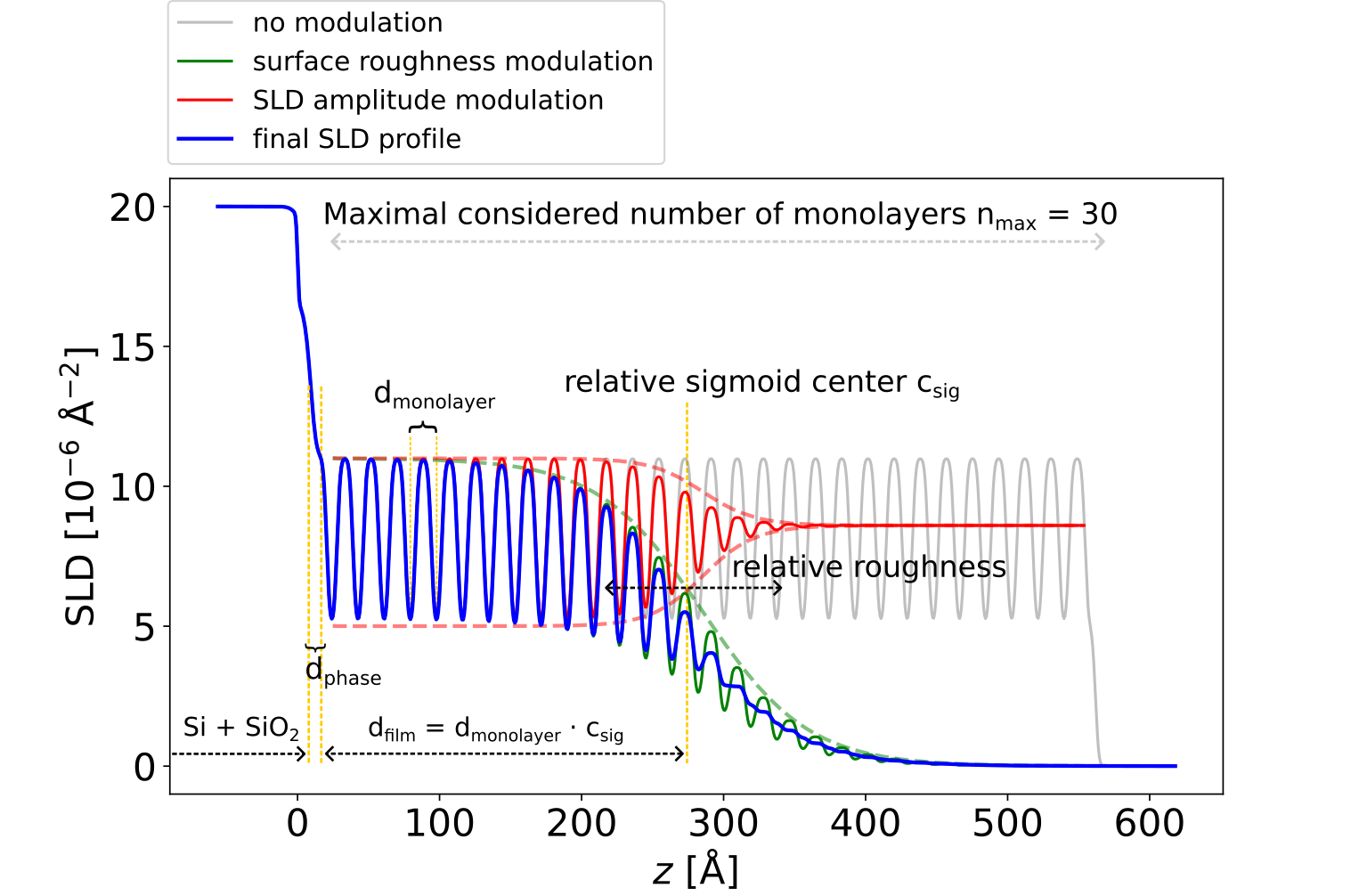
Fig. 6.1 SLD parameterization of a multilayer consisting of periodically repeating monolayers#
This parameterization is described by 17 film parameters, their physical description together with their corresponding alias in the YAML configuration file being shown in the following table:
Parameter description |
Parameter alias in the configuration file |
|---|---|
monolayer thickness (i.e. two boxes stacked together) |
d_block |
relative roughness of the monolayer interfaces (wrt. the monolayer thickness) |
s_block_rel |
SLD of the first box in the monolayer |
r_block |
SLD difference between the second and the first box in the monolayer |
dr |
fraction of the monolayer thickness belonging to the first box |
d_block1_rel |
roughness of the silicon substrate |
s_si |
SLD of the silicon substrate |
r_si |
thickness of the silicon oxide layer |
d_sio2 |
roughness of the silicon oxide layer |
s_sio2 |
SLD of the silicon oxide layer |
r_sio2 |
SLD of the phase layer |
r3 |
relative thickness of the phase layer (wrt. the monolayer thickness) |
d3_rel |
relative roughness of the phase layer (wrt. the monolayer thickness) |
s3_rel |
relative position of the first sigmoid (i.e. total film thickness) |
d_full_rel |
relative width of the first sigmoid |
rel_sigmas |
relative position of the second sigmoid (coherently ordered film thickness) |
dr_sigmoid_rel_pos |
relative width of the second sigmoid |
dr_sigmoid_rel_width |
We can initialize a reflectorch model which uses this type of SLD parameterization by making the following changes to the YAML configuration file:
Firstly, we set the
model_nameargument of the prior sampler torepeating_multilayer_v3instead ofstandard_model, and themax_num_layersargument to a high value representing the maximum considered number of monolayers (e.g. 30). In addition, the parameter ranges and bound width ranges for the 17 multilayer parameters must be specified (the above table shows the correspondance between the physical parameters and their YAML subkeys in the configuration file).
dset:
prior_sampler:
cls: SubpriorParametricSampler
kwargs:
param_ranges:
d_full_rel: [0, 25]
rel_sigmas: [0, 5]
dr_sigmoid_rel_pos: [-10, 10]
dr_sigmoid_rel_width: [0, 20]
d_block1_rel: [0.01, 0.99]
d_block: [10, 20]
s_block_rel: [0., 0.3]
r_block: [0., 20.]
dr: [-10., 10.]
d3_rel: [0, 1]
s3_rel: [0, 1]
r3: [0., 25]
d_sio2: [0, 10]
s_sio2: [0, 10]
s_si: [0., 10]
r_sio2: [17., 19.]
r_si: [19., 21.]
bound_width_ranges:
d_full_rel: [0.1, 25]
rel_sigmas: [0.1, 5]
dr_sigmoid_rel_pos: [0.1, 20]
dr_sigmoid_rel_width: [0.1, 20]
d_block1_rel: [0.01, 1.0]
d_block: [0.1, 10.]
s_block_rel: [0.1, 0.3]
r_block: [0.1, 5.]
dr: [0.1, 5.]
d3_rel: [0.01, 1]
s3_rel: [0.01, 1]
r3: [0.01, 25]
d_sio2: [0.01, 10]
s_sio2: [0.01, 10]
s_si: [0.01, 10]
r_sio2: [0.01, 2]
r_si: [0.01, 2]
model_name: repeating_multilayer_v3
max_num_layers: 30
logdist: false
scale_params_by_ranges: false
scaled_range: [-1., 1.]
device: 'cuda'
The neural network architecture must be set up such that the
dim_outargument (i.e. the output dimension) is set to the number of predicted parameters which in this case is 17.
model:
network:
cls: NetworkWithPriors
pretrained_name: null
device: 'cuda'
kwargs:
embedding_net_type: 'conv'
embedding_net_kwargs:
in_channels: 1
hidden_channels: [32, 64, 128, 256, 512]
dim_embedding: 128
dim_avpool: 1
activation: 'gelu'
use_batch_norm: true
pretrained_embedding_net: null
dim_out: 17
layer_width: 512
num_blocks: 6
repeats_per_block: 2
mlp_activation: 'gelu'
dropout_rate: 0.0
conditioning: 'concat'
6.1.2.1. Training#
We initialize a model from a suitable configuration file. Here we use an extended q range, up to 0.5 Å\(^{-1}\).
trainer = get_trainer_by_name(config_name='c_repeating_multilayer', load_weights=False)
Model c_repeating_multilayer loaded. Number of parameters: 3.85 M
Show code cell source
simulated_data = trainer.loader.get_batch(batch_size=64)
n_layers = simulated_data['params'].max_layer_num
n_params = simulated_data['params'].num_params
print(f'Max number of layers: {n_layers}, Number of film parameters: {n_params}')
Max number of layers: 30, Number of film parameters: 17
Show code cell source
q = to_np(simulated_data['q_values'])[0]
scaled_noisy_curves = simulated_data['scaled_noisy_curves']
i = 3
fig, ax = plt.subplots(1,2,figsize=(12,6))
ax[0].set_ylim(-1.1, 1.1)
ax[0].set_xlabel('q [$Å^{-1}$]', fontsize=18)
ax[0].set_ylabel('R$_{scaled}$ (q)', fontsize=18)
ax[0].tick_params(axis='both', which='major', labelsize=14)
ax[0].scatter(q, to_np(scaled_noisy_curves[i]), c='blue', s=2.0);
z_axis = torch.linspace(-200, 1000, 1000, device='cuda')
_, sld_profile, _ = get_density_profiles(
simulated_data['params'].thicknesses,
simulated_data['params'].roughnesses,
simulated_data['params'].slds,
z_axis=z_axis)
ax[1].plot(z_axis.cpu().numpy(), to_np(sld_profile[i]), c='b', label='ground truth')
ax[1].set_xlabel('z [$Å$]', fontsize=20)
ax[1].set_ylabel('SLD [$10^{-6} Å^{-2}$]', fontsize=20)
ax[1].tick_params(axis='both', which='major', labelsize=15)
ax[1].tick_params(axis='both', which='minor', labelsize=15)
plt.tight_layout()
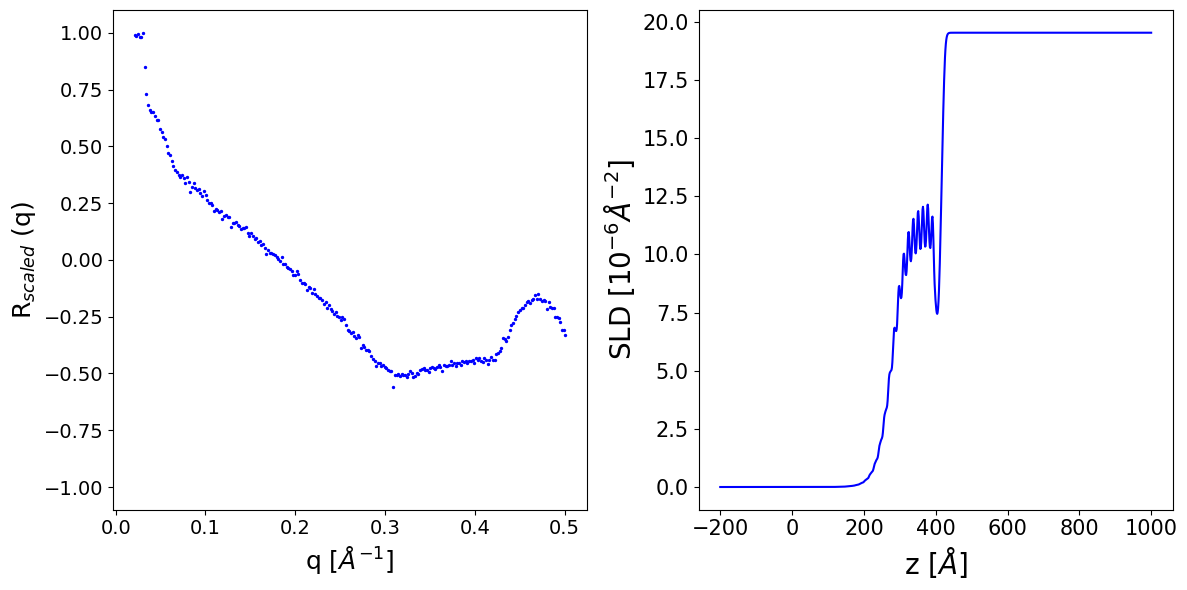
6.1.2.2. Inference#
Here, we perform inference on experimental data using a pretrained model.
inference_model = InferenceModel(
config_name='g_mc_point_xray_conv_repeating_n256_size1024',
device='cpu'
)
Configuration file `D:\Github Projects\reflectorch\reflectorch\configs\g_mc_point_xray_conv_repeating_n256_size1024.yaml` found locally.
Weights file `D:\Github Projects\reflectorch\reflectorch\saved_models\model_g_mc_point_xray_conv_repeating_n256_size1024.safetensors` found locally.
Model g_mc_point_xray_conv_repeating_n256_size1024 loaded. Number of parameters: 20.63 M
The model corresponds to a `repeating_multilayer_v3` parameterization with 30 layers (19 predicted parameters)
Parameter types and total ranges:
- d_full_rel: [0, 25]
- rel_sigmas: [0, 5]
- dr_sigmoid_rel_pos: [-10, 10]
- dr_sigmoid_rel_width: [0, 20]
- d_block1_rel: [0.01, 0.99]
- d_block: [10, 20]
- s_block_rel: [0.0, 0.3]
- r_block: [0.0, 20.0]
- dr: [-10.0, 10.0]
- d3_rel: [0, 1]
- s3_rel: [0, 1]
- r3: [0.0, 25]
- d_sio2: [0, 10]
- s_sio2: [0, 10]
- s_si: [0.0, 10]
- r_sio2: [17.0, 19.0]
- r_si: [19.0, 21.0]
- q_shift: [-0.002, 0.002]
- r_scale: [0.9, 1.1]
Allowed widths of the prior bound intervals (max-min):
- d_full_rel: [0.1, 25]
- rel_sigmas: [0.1, 5]
- dr_sigmoid_rel_pos: [0.1, 20]
- dr_sigmoid_rel_width: [0.1, 20]
- d_block1_rel: [0.01, 1.0]
- d_block: [0.1, 10.0]
- s_block_rel: [0.1, 0.3]
- r_block: [0.1, 5.0]
- dr: [0.1, 5.0]
- d3_rel: [0.01, 1]
- s3_rel: [0.01, 1]
- r3: [0.01, 25]
- d_sio2: [0.01, 10]
- s_sio2: [0.01, 10]
- s_si: [0.01, 10]
- r_sio2: [0.01, 2]
- r_si: [0.01, 2]
- q_shift: [0.01, 0.004]
- r_scale: [0.01, 0.2]
The model was trained on curves discretized at 256 uniform points between q_min=0.02 and q_max=0.5
The following quantities are additional inputs to the network: prior bounds.
We load an experimental curve and make a prediction:
multilayer_data_path = EXP_DATA_DIR / 'DIP-nSi_34a.dat'
data = np.genfromtxt(multilayer_data_path, delimiter='\t', skip_header=0, unpack=True)
q_exp = data[0][:344]
curve_exp = data[1][:344]
prior_bounds = [
(5., 20.), #relative sigmoid center
(0., 5.), #relative roughness
(-10., 10.), #position of the second sigmoid relative to d_full_rel (units are d_block)
(0., 20.), #width of the second sigmoid relative to d_full_rel (units are d_block)
(0.6, 0.9), #fractional thickness of one box1 in the monolayer
(16., 17.5), #thickness of one monolayer (two boxes stacked together)
(0.05, 0.3), #roughness of each interface in the monolayer relative to d_block
(5., 20.), ##SLD of box1 in the multilayer
(-10, -5), #dr = SLD(box2) - SLD(box1)
(0, 1), #relative thickness of phase layer with respect to d_block
(0, 1), #relative roughness of phase layer with respect to d_block
(5, 15), #SLD of phase layer
(5, 10), #thickness SiO2
(0, 10), #roughness SiO2
(0, 10), #roughness Si
(17., 18.), #SLD SiO2
(19.5, 20.5), #SLD Si
###Additional nuisance parameters:
(-0.002, 0.002), #q_shift
(0.9, 1.1), #r_scale
]
Show code cell source
prediction_dict = inference_model.preprocess_and_predict(
reflectivity_curve=curve_exp,
q_values=q_exp,
prior_bounds=prior_bounds,
clip_prediction=True,
#polish_prediction=True,
calc_pred_curve=True,
calc_pred_sld_profile=True,
calc_polished_sld_profile=True,
)
pred_params = prediction_dict['predicted_params_array']
pred_curve = prediction_dict['predicted_curve']
#polished_curve = prediction_dict['polished_curve']
q_plot = prediction_dict['q_plot_pred']
print_prediction_results(prediction_dict)
fig, ax = plot_reflectivity(
q_exp=q_exp, r_exp=curve_exp,
q_pred=q_plot, r_pred=pred_curve,
#q_pol=q_exp, r_pol=polished_curve,
plot_sld_profile=True, z_sld=prediction_dict['predicted_sld_xaxis'],
sld_pred=prediction_dict['predicted_sld_profile'],
#sld_pol=prediction_dict['sld_profile_polished'],
)
Parameter Predicted
--------------------------------
d_full_rel 12.083
rel_sigmas 1.056
dr_sigmoid_rel_pos -1.314
dr_sigmoid_rel_width 15.209
d_block1_rel 0.744
d_block 16.505
s_block_rel 0.052
r_block 11.986
dr -9.824
d3_rel 0.057
s3_rel 0.521
r3 9.638
d_sio2 6.701
s_sio2 1.551
s_si 2.344
r_sio2 17.523
r_si 20.251
q_shift -0.000
r_scale 0.900
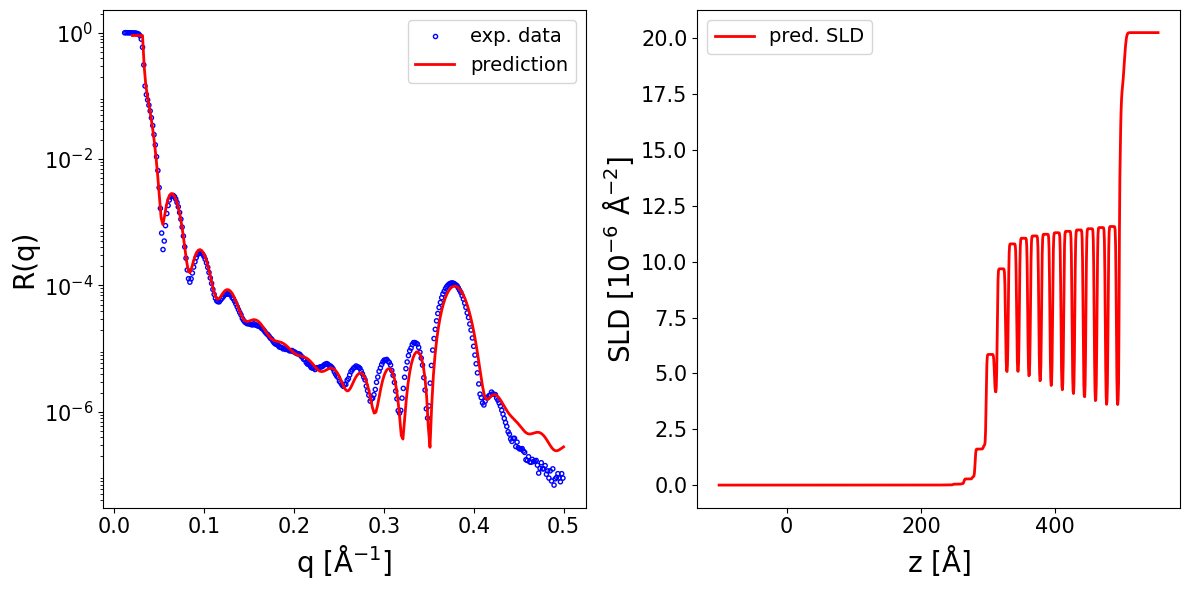
6.1.3. Parameterizations with nuisance parameters (experimental imperfections)#
To account for experimental imperfections in reflectometry measurements, any of the parameterizations in reflectorch can be extended to include nuisance parameters. These parameters model common experimental artifacts that affect the measured reflectivity curve:
r_scale: A multiplicative scaling factor for the reflectivity, accounting for imperfect intensity normalization.q_shift: A shift in the momentum transfer vector q, modeling misalignment or sample positioning errors.log10_background: A constant background term (here defined in log space), often seen in neutron reflectometry experiments.
These nuisance parameters can be incorporated into the prior sampling configuration, as shown below. Each parameter can be individually enabled or disabled via the shift_param_config dictionary. When enabling additional parameters:
ensure the neural network’s output dimension (
dim_out) matches the total number of predicted parameters (parameters of the base parameterization + nuisance parameters)when performing inference, the list of prior bounds must include any enabled nuisance parameters in the correct order
dset:
cls: ReflectivityDataLoader
prior_sampler:
cls: SubpriorParametricSampler
kwargs:
param_ranges:
thicknesses: [1., 1500.]
roughnesses: [0., 60.]
slds: [-8., 16.]
q_shift: [-0.002, 0.002]
r_scale: [0.9, 1.1]
log10_background: [-10.0, -4.0]
bound_width_ranges:
thicknesses: [1.0e-2, 1500.]
roughnesses: [1.0e-2, 60.]
slds: [1.0e-2, 5.]
q_shift: [1.0e-2, 0.004]
r_scale: [1.0e-2, 0.2]
log10_background: [1.0e-2, 6.0]
shift_param_config:
q_shift: false
r_scale: true
log10_background: true
model_name: standard_model
max_num_layers: 1
constrained_roughness: true
max_thickness_share: 0.5
logdist: false
scale_params_by_ranges: false
scaled_range: [-1., 1.]
device: 'cuda'
6.2. Using alternative embedding networks#
6.2.1. Training#
Embedding networks have the role of processing the reflectivity curves, producing a latent representation which is fed together with the prior bounds to the main fully-connected (MLP) network in order to obtain the predictions. The default embedding network is the 1D CNN, whose arguments have been already explained in the previous section.
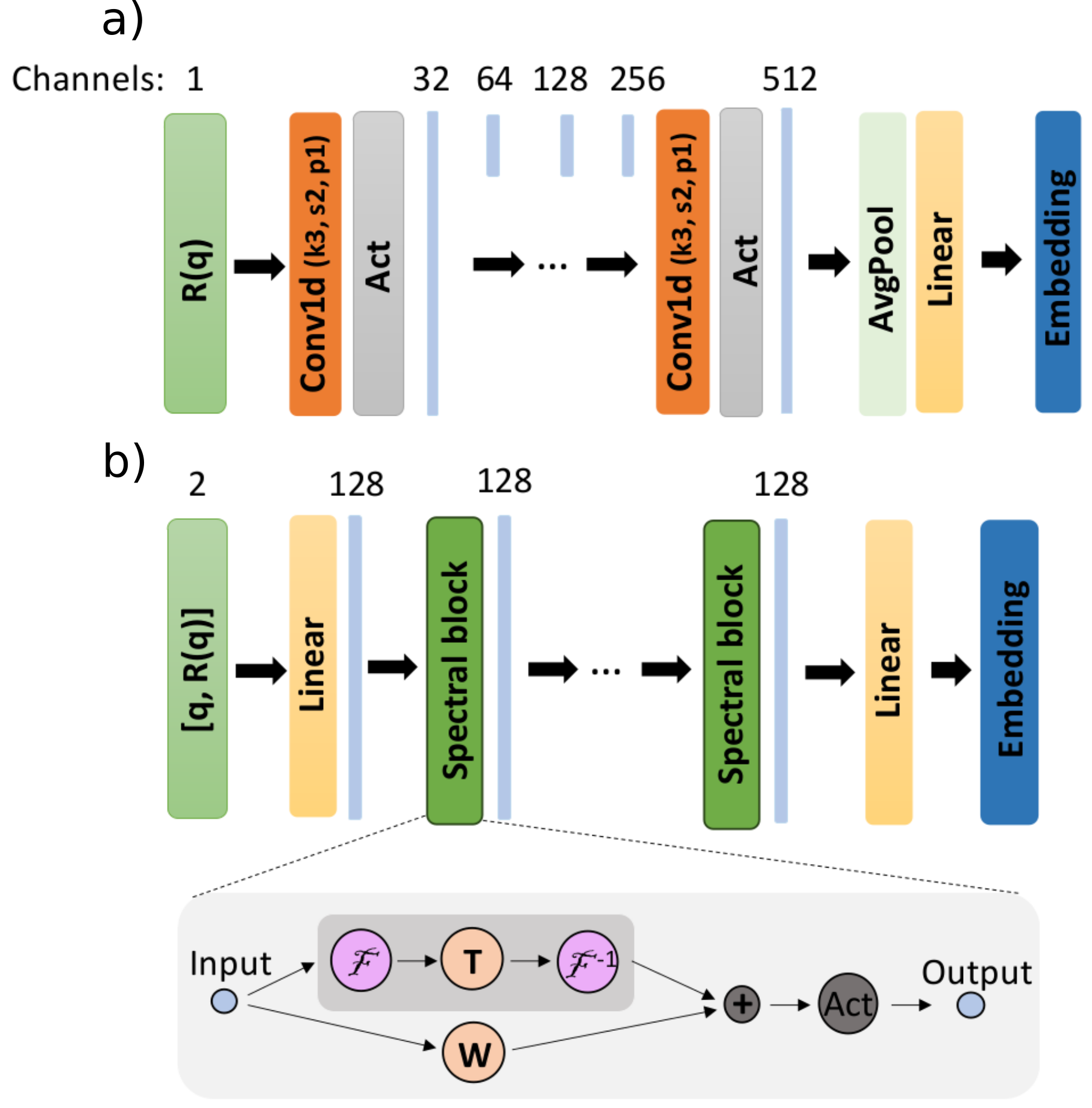
Fig. 6.2 Embedding networks: (a) CNN (b) FNO#
Alternatively, we can use an embedding network inspired by the Fourier Neural Operator (FNO) architecture. In this scenario the reflectivity curves together with their respective q-values are input to the embedding network. It allows us to train the model on reflectivity curves with variable discretizations (variable q ranges and numbers of points in the curves).
We can initialize a reflectorch model which uses the FNO-based embedding network by making the following changes to the YAML configuration file:
Firstly, the
q_generatorhas to be changed toVariableQ. Its arguments are:
q_min_range- the range for sampling the minimum q value of the curves, q_minq_max_range- the range for sampling the maximum q value of the curves, q_maxn_q_range- the range for the number of points in the curves (equidistantly sampled between q_min and q_max, the number of points varies between batches but is constant within a batch)
dset:
q_generator:
cls: VariableQ
kwargs:
q_min_range: [0.01, 0.03]
q_max_range: [0.15, 0.4]
n_q_range: [128, 256]
device: 'cuda'
We can change the embedding network while keeping the architecture of the MLP intact. The
embedding_net_typekeyword argument of the network will befno. We also have to provide the arguments for this specific embedding network, which in this case are:
in_channels- the number of input channels to the FNO-based embedding network (should be 2, i.e. (R(q), q))dim_embedding- the dimension of the embedding produced by the FNOwidth_fno- the number of channels in the FNO blocksn_fno_blocks- the number of FNO blocksmodes- the number of Fourier modes that are utilizedactivation- the type of activation function in the embedding networkfusion_self_attention- ifTruea fusion layer is used after the FNO blocks to produce the final outputfsa_activation- the type of activation function in fusion self attention layer
model:
network:
cls: NetworkWithPriors
pretrained_name: null
device: 'cuda'
kwargs:
embedding_net_type: 'fno'
embedding_net_kwargs:
in_channels: 2
dim_embedding: 128
width_fno: 128
n_fno_blocks : 4
modes: 16
activation: 'gelu'
fusion_self_attention: true
fsa_activation: 'gelu'
The
train_with_q_inputargument oftrainer_kwargsmust be set toTrue.
training:
trainer_cls: PointEstimatorTrainer
num_iterations: 10000
batch_size: 4096
lr: 1.0e-3
grad_accumulation_steps: 1
clip_grad_norm_max: 1.0
update_tqdm_freq: 1
optimizer: AdamW
trainer_kwargs:
train_with_q_input: true
6.2.2. Inference#
We perform inference on the two curves previously shown in the Using reflectorch tutorial:
inference_model = InferenceModel(config_name='mc-o4', device='cpu')
Configuration file `D:\Github Projects\reflectorch\reflectorch\configs\mc-o4.yaml` found locally.
Weights file `D:\Github Projects\reflectorch\reflectorch\saved_models\model_mc-o4.safetensors` found locally.
Model mc-o4 loaded. Number of parameters: 14.61 M
The model corresponds to a `standard_model` parameterization with 2 layers (8 predicted parameters)
Parameter types and total ranges:
- thicknesses: [0.0, 500.0]
- roughnesses: [0.0, 20.0]
- slds: [0.0, 50.0]
Allowed widths of the prior bound intervals (max-min):
- thicknesses: [0.01, 500.0]
- roughnesses: [0.01, 20.0]
- slds: [0.01, 5.0]
The model was trained on curves discretized at a number between 128 and 256 of uniform points between q_min in [0.01, 0.05] and q_max in [0.15, 0.4]
The following quantities are additional inputs to the network: prior bounds, q values.
data = np.loadtxt(EXP_DATA_DIR / 'data_PTCDI-C3.txt', delimiter='\t', skiprows=1)
q_exp = data[..., 0]
curve_exp = data[..., 1]
print(curve_exp.shape, q_exp.shape, q_exp.min(), q_exp.max())
prior_bounds = [
(1., 400.), #layer thicknesses (top to bottom)
(1., 10.),
(0., 20.), #interlayer roughnesses (top to bottom)
(0., 15.),
(0., 15.),
(10., 13.), #real layer slds (top to bottom)
(20., 21.),
(20., 21.)
]
prediction_dict = inference_model.preprocess_and_predict(
reflectivity_curve=curve_exp,
q_values=q_exp,
prior_bounds=prior_bounds,
clip_prediction=True,
polish_prediction=False,
calc_pred_curve=True,
calc_pred_sld_profile=True,
sld_profile_padding_left=0.4,
sld_profile_padding_right=1.2,
)
for key in prediction_dict.keys():
print(key)
pred_params = prediction_dict['predicted_params_array']
pred_curve = prediction_dict['predicted_curve']
q_plot = prediction_dict['q_plot_pred']
(141,) (141,) 0.0142368058 0.213456644
predicted_params_object
predicted_params_array
param_names
predicted_curve
predicted_sld_profile
predicted_sld_xaxis
q_plot_pred
q_model
reflectivity_curve_interp
Show code cell source
print_prediction_results(prediction_dict)
fig, ax = plot_reflectivity(
q_exp=q_exp, r_exp=curve_exp,
q_pred=q_plot, r_pred=pred_curve,
plot_sld_profile=True, z_sld=prediction_dict['predicted_sld_xaxis'],
sld_pred=prediction_dict['predicted_sld_profile'],
)
Parameter Predicted
--------------------------
Thickness L1 186.598
Thickness L2 8.875
Roughness L1 19.921
Roughness L2 3.643
Roughness sub 5.712
SLD L1 11.169
SLD L2 20.330
SLD sub 20.533
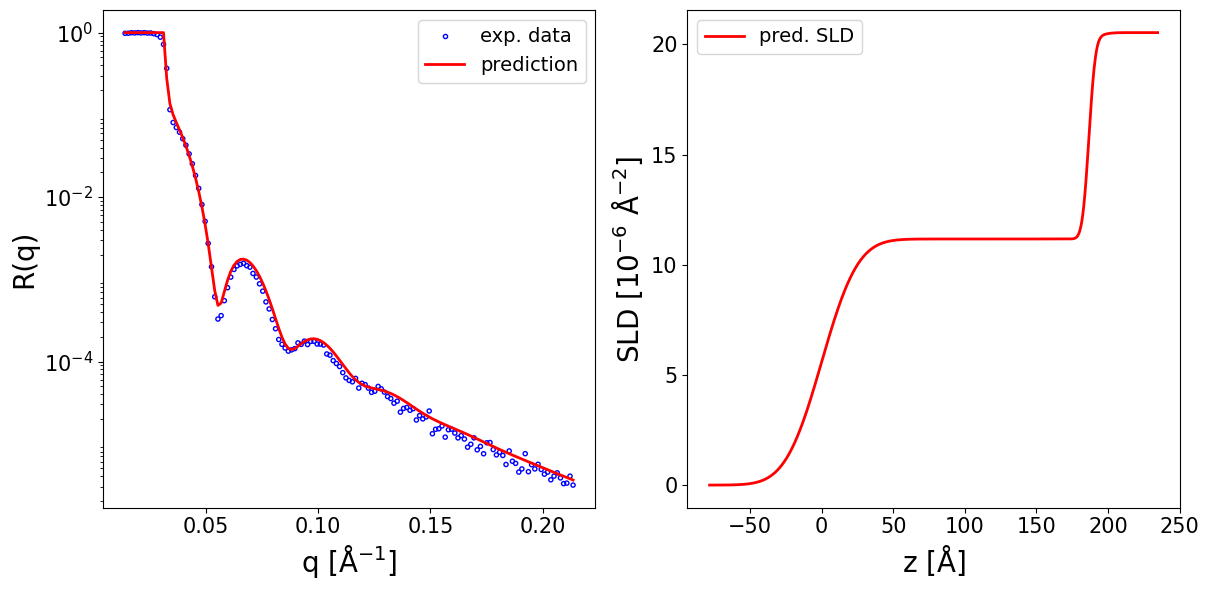
data = np.loadtxt(EXP_DATA_DIR / 'data_C60.txt', delimiter='\t', skiprows=1)
q_exp = data[..., 0]
curve_exp = data[..., 1]
print(curve_exp.shape, q_exp.shape, q_exp.min(), q_exp.max())
prior_bounds = [
(1., 400.), #layer thicknesses (top to bottom)
(1., 10.),
(0., 20.), #interlayer roughnesses (top to bottom)
(0., 15.),
(0., 15.),
(13., 18.), #real layer slds (top to bottom)
(20., 21.),
(20., 21.)
]
prediction_dict = inference_model.preprocess_and_predict(
reflectivity_curve=curve_exp,
q_values=q_exp,
prior_bounds=prior_bounds,
clip_prediction=True,
polish_prediction=True,
calc_pred_curve=True,
calc_pred_sld_profile=True,
calc_polished_sld_profile=True,
sld_profile_padding_left=0.4,
sld_profile_padding_right=1.2,
)
for key in prediction_dict.keys():
print(key)
pred_params = prediction_dict['predicted_params_array']
pred_curve = prediction_dict['predicted_curve']
polished_curve = prediction_dict['polished_curve']
q_plot = prediction_dict['q_plot_pred']
(91,) (91,) 0.0142368058 0.142432068
predicted_params_object
predicted_params_array
param_names
predicted_curve
predicted_sld_profile
predicted_sld_xaxis
q_plot_pred
q_model
reflectivity_curve_interp
polished_params_array
polished_params_error_array
polished_curve
sld_profile_polished
Show code cell source
fig, ax = plot_reflectivity(
q_exp=q_exp, r_exp=curve_exp,
q_pred=q_plot, r_pred=pred_curve,
q_pol=q_exp, r_pol=polished_curve,
plot_sld_profile=True, z_sld=prediction_dict['predicted_sld_xaxis'],
sld_pred=prediction_dict['predicted_sld_profile'],
sld_pol=prediction_dict['sld_profile_polished'],
)
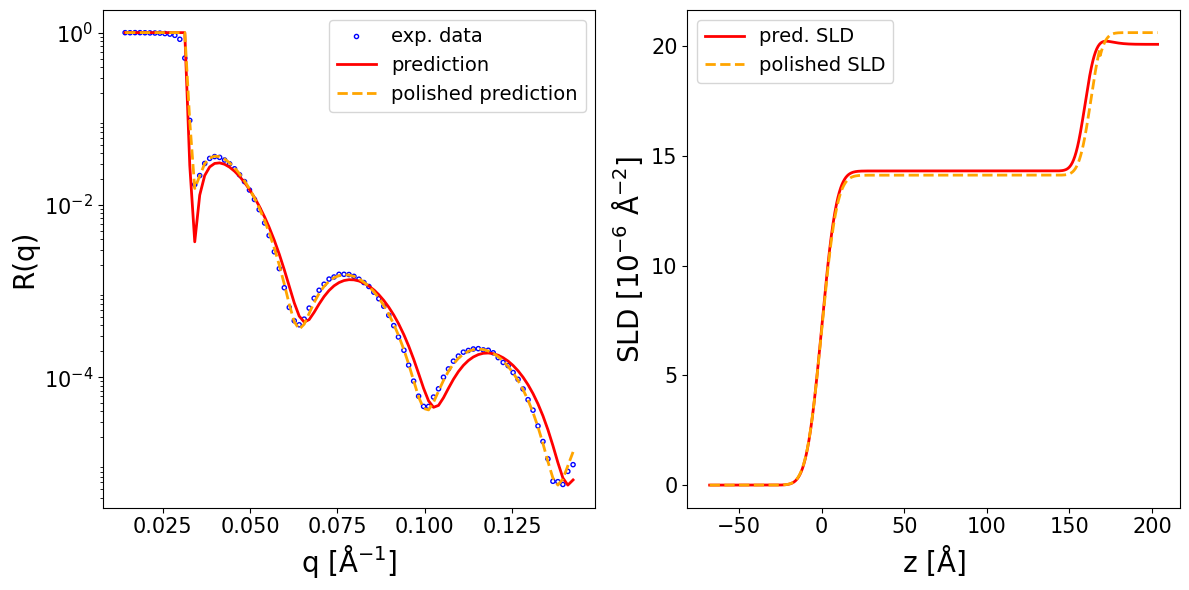
6.3. Using alternative trainers#
By default the class of the trainer object is PointEstimatorTrainer, whose purpose is to train the neural network as a regression problem for predicting the physical parameters based on the reflectivity curves and the prior bounds for the parameters. Other types of trainers can also be specified, for example a trainer used for encoding reflectivity curves to latent representation.
In the configuration file, the trainer_cls subkey of the training key is set to DenoisingAETrainer:
training:
trainer_cls: DenoisingAETrainer
We also select an appropriate neural network for this task:
model:
network:
cls: ConvAutoencoder
pretrained_name: null
device: 'cuda'
kwargs:
in_channels: 1
encoder_hidden_channels: [32, 64, 128, 256, 512]
decoder_hidden_channels: [512, 256, 128, 64, 32]
dim_latent: 64
dim_avpool: 1
use_batch_norm: true
activation: 'gelu'
decoder_in_size: 4 # num_q_points / 32
trainer = get_trainer_by_name(config_name='c_ae', load_weights=False)
print(trainer)
Model c_ae loaded. Number of parameters: 1.22 M
<reflectorch.ml.trainers.DenoisingAETrainer object at 0x000002709114E160>
trainer.model
ConvAutoencoder(
(encoder): ConvEncoder(
(core): Sequential(
(0): Sequential(
(0): Conv1d(1, 32, kernel_size=(3,), stride=(2,), padding=(1,))
(1): BatchNorm1d(32, eps=1e-05, momentum=0.1, affine=True, track_running_stats=True)
(2): GELU(approximate='none')
)
(1): Sequential(
(0): Conv1d(32, 64, kernel_size=(3,), stride=(2,), padding=(1,))
(1): BatchNorm1d(64, eps=1e-05, momentum=0.1, affine=True, track_running_stats=True)
(2): GELU(approximate='none')
)
(2): Sequential(
(0): Conv1d(64, 128, kernel_size=(3,), stride=(2,), padding=(1,))
(1): BatchNorm1d(128, eps=1e-05, momentum=0.1, affine=True, track_running_stats=True)
(2): GELU(approximate='none')
)
(3): Sequential(
(0): Conv1d(128, 256, kernel_size=(3,), stride=(2,), padding=(1,))
(1): BatchNorm1d(256, eps=1e-05, momentum=0.1, affine=True, track_running_stats=True)
(2): GELU(approximate='none')
)
(4): Sequential(
(0): Conv1d(256, 512, kernel_size=(3,), stride=(2,), padding=(1,))
(1): BatchNorm1d(512, eps=1e-05, momentum=0.1, affine=True, track_running_stats=True)
(2): GELU(approximate='none')
)
)
(avpool): AdaptiveAvgPool1d(output_size=1)
(fc): Linear(in_features=512, out_features=64, bias=True)
)
(decoder): ConvDecoder(
(decoder_input): Linear(in_features=64, out_features=2048, bias=True)
(decoder): Sequential(
(0): Sequential(
(0): ConvTranspose1d(512, 256, kernel_size=(3,), stride=(2,), padding=(1,), output_padding=(1,))
(1): BatchNorm1d(256, eps=1e-05, momentum=0.1, affine=True, track_running_stats=True)
(2): GELU(approximate='none')
)
(1): Sequential(
(0): ConvTranspose1d(256, 128, kernel_size=(3,), stride=(2,), padding=(1,), output_padding=(1,))
(1): BatchNorm1d(128, eps=1e-05, momentum=0.1, affine=True, track_running_stats=True)
(2): GELU(approximate='none')
)
(2): Sequential(
(0): ConvTranspose1d(128, 64, kernel_size=(3,), stride=(2,), padding=(1,), output_padding=(1,))
(1): BatchNorm1d(64, eps=1e-05, momentum=0.1, affine=True, track_running_stats=True)
(2): GELU(approximate='none')
)
(3): Sequential(
(0): ConvTranspose1d(64, 32, kernel_size=(3,), stride=(2,), padding=(1,), output_padding=(1,))
(1): BatchNorm1d(32, eps=1e-05, momentum=0.1, affine=True, track_running_stats=True)
(2): GELU(approximate='none')
)
)
(final_layer): Sequential(
(0): ConvTranspose1d(32, 32, kernel_size=(3,), stride=(2,), padding=(1,), output_padding=(1,))
(1): BatchNorm1d(32, eps=1e-05, momentum=0.1, affine=True, track_running_stats=True)
(2): GELU(approximate='none')
(3): Conv1d(32, 1, kernel_size=(3,), stride=(1,), padding=(1,))
)
)
)
